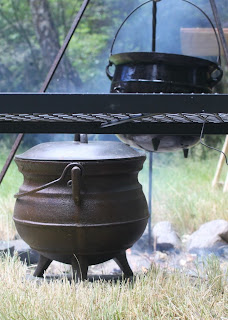I've really been looking forward to this one.
If nothing else, this project gives me a chance to post an image from Bartolomeo Scappi instead of my muse/nemesis Jost Amman for a change. Scappi (died 1570) was the personal chef of six popes. His renown, however, is mostly for his magnum opus: Opera di Bartolomeo Scappi, Maestro dell'arte del cucinare, divisa in sei libri (roughly: "The Work of Bartolomeo Scappi, Master of the art of cooking, in six volumes"). Scappi's Opera (as it's known) is at once a gossipy memoir of life as the Vatican chef and a manual of instruction for the state of the culinary art, circa 1550-1570. It contains over a thousand recipes/preparations, and is probably the most thorough accounting of the renaissance kitchen that we have available to us.
It also includes a large number of drawings depicting kitchens both inside and outside and all the implements that one could hope to reproduce. Best of all, you can download it free from the Internet Archive. http://archive.org/details/operavenetiascap00scap

Scappi, unfortunately, was decidedly not English. So we'll be using his 'Opera' as one of many resources as we work from period or near-period English recipes wherever possible. Additionally, we'll be using some of the resources produced by the fine folks who put on the cooking demonstrations for the Historic Royal Palaces. Between Scappi and the fine folks at HRP, I think we're in good hands.
It also includes a large number of drawings depicting kitchens both inside and outside and all the implements that one could hope to reproduce. Best of all, you can download it free from the Internet Archive. http://archive.org/details/operavenetiascap00scap

Scappi, unfortunately, was decidedly not English. So we'll be using his 'Opera' as one of many resources as we work from period or near-period English recipes wherever possible. Additionally, we'll be using some of the resources produced by the fine folks who put on the cooking demonstrations for the Historic Royal Palaces. Between Scappi and the fine folks at HRP, I think we're in good hands.
But before I get to all that, I have to learn to cook with fire.
Looking at that engraving up there, it seems simple enough:
Looking at that engraving up there, it seems simple enough:
- Light fire.
- food over roaring fire.
- Eat and repeat.
Can you hear me humming "Smoke gets in your eyes"?
Yeah...
A word about cookware and safety...
The Elizabethans didn't know a thing about bacteria or food poisoning. Their grasp on metallurgy was
pretty good, though, and getting better all the time. Yet they used some metals and alloys with furious abandon that we now understand to be catastrophic to your health. They practically poured lead on their breakfast cereal.
pretty good, though, and getting better all the time. Yet they used some metals and alloys with furious abandon that we now understand to be catastrophic to your health. They practically poured lead on their breakfast cereal.
Lead isn't really a relevant worry here since its use is so constrained in modern manufacturing. The place most Elizabethans encountered it was in the glazes of their ceramics and as a potter I can control for that pretty easily. My main deviation from the period is eschewing bronze entirely. Those cauldrons you see in all the paintings? Most of them were cast in the same manner as church bells and from mostly the same materials.
The biggest problem with bronze (aside from weight and expense) is that it's an alloy mostly consisting of copper. In the period it might be blended with lead or zinc, neither of which are good eats, but even modern bronze has its problems and perils.
I use copper all the time because I have some copper cookware in my kitchen and it tends to be lined with tin if it's intended for household use. But all my cauldrons are cast iron, which is most assuredly not a period metal. Why the deviation? Because cast iron is easier to clean and care for, less expensive, and even if I screw up completely, it won't poison anyone.
Is that really a danger? Sort of... certainly more of a problem than I'm willing to bear on my conscience. When copper comes in contact with acids it can create a chemical reaction that forms what's known as verdigris. That's the green patina that forms on copper as it weathers. And it's poisonous.
Scrupulous cleaning can keep you safe and the folks at Hampton Court Palace use bronze cookware that was made for them (I believe) by the folks at Historic Castings.
Thermal mass is the key here. As far as I can tell, the choice of metals for my cookware doesn't change the results and the transfer of heat from fire to food doesn't change all that much.
Thermal mass is the key here. As far as I can tell, the choice of metals for my cookware doesn't change the results and the transfer of heat from fire to food doesn't change all that much.
Speaking of cleanliness, I have pots to clean...
More later.
- Scott



Excellent, I am following & I have shared. Well done.
ReplyDeleteRegards, Keith.
http://woodsrunnersdiary.blogspot.com.au
It seems that no matter where you set up, the wind will change so that you are downwind from the smoke. It is some kind of natural law.
ReplyDelete